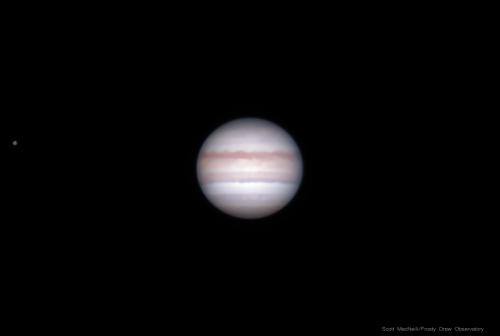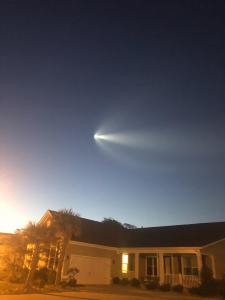Celebration of Space - September 23, 2022
On Monday, September 26, 2022, Earth will arrive at the point in our orbit around the Sun where we are aligned with the Sun and Jupiter. This will place Jupiter on the opposite side of Earth than the Sun, and is called the Opposition of Jupiter, which will put Jupiter into the best viewing for the year. On the day of opposition, Jupiter will rise at sunset, and set at sunrise. Jupiter will also be the closest to Earth for our year during opposition at around 367.454 million miles distant.
Being the fifth planet from the Sun, Jupiter has a much larger orbit around the Sun than we do, and takes about 12 years to complete one full orbital period. This will result in Jupiter advancing about 33° eastward in the sky against the constellations every year on Earth. Due to this change in position, we experience opposition with Jupiter every 13.2 months, a little over one year’s time.
The best times to view an outer planet is during the weeks surrounding opposition, with the days leading up to, and trailing opposition, being the best of the best. Jupiter will be in this period tonight at Frosty Drew Observatory. So stop in and see the giant planet in a telescope with your own eyes.
Over the course of our year, several meteor showers will occur. Some showers bring a lot of fast moving, dim meteors. While others will bring slower moving meteors, and super bright fireball meteors. Most notable showers of the year are known for producing many dim meteors, which will make up the majority of the shower, with the occasional fireball meteor happening. Though the Taurid meteor showers are more known for their high rate of fireball meteor activity.
A fireball meteor is a meteor that is much brighter than your average shooting star. They usually last much longer, and can streak across the entire sky. Some fireball meteors are bright enough to completely light up the landscape. We have seen fireball meteors at Frosty Drew flicker as they pass by, or fragment, which is when parts of the meteor break up or break off. Some fireball meteors are classified as bolide meteors which will explode when passing over, and can be heard. The vast majority of fireball meteors reported from September – November are associated with the Taurid meteor showers.
The first shower – the Southern Taurid Meteor Shower will kick in on Wednesday, September 28, 2022. The second shower – the Northern Taurid Meteor Shower will join in on October 13, 2022. During the overlap period, which will last from October 13th – December 2nd, the best display will occur. Now the Taurid meteor showers appear to have a predictable period of increased fireball activity that cycles every seven years. The last increase occurred in 2015, which produced a remarkable amount of fireball meteors. At Frosty Drew we were seeing about 1-3 fireball meteors per night! Well 2022 is the next predicted year of increased fireball activity. As these showers ramp up, we will be writing about what we are seeing and the prospects that we think exist for fireball viewing. In any case, be sure to keep an eye on the sky this autumn, as you just may spot a fabulous fireball meteor streaking across the sky.
Tomorrow night, Saturday, September 24, 2022 at 7:32 pm, the SpaceX Starlink 4-35 launch is scheduled to occur on the Falcon 9 launch vehicle. This launch is happening at Cape Canaveral Florida, and may be visible to sky watchers in Southern New England. Last Sunday night, a Starlink launch occurred at Cape Canaveral, and about 10 minutes later, the launch vehicle was visible from Newport, Rhode Island, even through heavy haze, about 35° over the south sky. SpaceX doesn’t generally publish visibility maps, though launches from Cape Canaveral have a probability of being visible along the East Coast. If you are up for a try, you should set out to a location with a good view of the southern sky, potentially the southern horizon. Be there for the launch time. About 10 minutes after the launch happens, be sure to scan the entire southern sky, as you just may see it. SpaceX launches are usually quite dramatic, and being that this launch is happening during the twilight hours, the launch vehicle may end up in direct sunlight, which would put on an amazing show! Will you see it, we aren’t sure, but the prospects of an amazing view are just too bold to pass up. If you happen to see it, be sure to let us know either at astronomer@frostydrew.org, or on our Facebook.
Save the Date: International Observe the Moon Night
On Saturday, October 1, 2022, the Frosty Drew Observatory and Science Center will celebrate International Observe the Moon Night with views of the Moon in our numerous telescopes, presentations about the Moon, and video clips of the Moon around our campus. This is our night at Frosty Drew to make amends with the Moon for all the complaining we do about it being too bright. On this night, thousands of schools, libraries, and science organizations around the world will host events to spotlight Earth’s only natural satellite. The Moon will be in a beautiful 36% waxing crescent phase, which will show a stunning view of Earthshine, which is when the shadow side of the Moon is visible due to sunlight reflecting off of Earth and illuminating the nighttime regions of the Moon. We will have our 24 inch PlaneWave offering close up views of craters and lunar maria. Our Courtyard telescopes will offer a full view of the Moon, with another telescope offering a wide field view of the entire Moon against the sky. The Lunar Lounge will be set up with a live view of the Moon projected from a telescope onto the exterior Sky Theatre wall. NASA Solar System ambassador, Frank Puglia, will be presenting in the Sky Theatre. Our event will run from 6:30 pm – 10:30 pm. Put the date on your calendar and stop in for a fantastic night with the Moon.
Evening passes of the International Space Station (ISS) will continue this week over our region. Though most of the best passes of this current cycle have already occurred, you still can catch a good view of the ISS zooming by. Here are a few pass times for this weekend and coming week:
Fri, Sep 23 at 7:11 pm, starting in the WNW, rising to 18°, heading towards the NNE
Sat, Sep 24 at 8:00 pm, starting in the NW, rising to 14°, heading towards the NNE
Sun, Sep 25 at 8:48 pm, starting in the NNW, rising to 17°, and into orbital sunset
Mon, Sep 26 at 8:00 pm, staring in the NNW, rising to 16°, heading towards the NNE, and into orbital sunset
Tue, Sep 27 at 8:48 pm, starting in the NW, rising to 21°, and into orbital sunset
Wed, Sep 28 at 7:59 pm, starting in the NW, rising to 23°, heading towards the NNE, and into orbital sunset
Thu, Sep 29 at 8:47 pm, starting in the NW, rising to 26°, and into orbital sunset
Note that these pass times are for Southern New England sky watchers, and are generally acceptable for all locations in the Northeast. For daily pass times of the ISS, and other bright satellites, visit the Frosty Drew Daily Satellite Pass Prediction Utility. Now put these times on your calendar and set your alarms to catch a view of humanity’s only continuously inhabited space-based residence passing over.
- Author:
- Scott MacNeill
- Entry Date:
- Sep 23, 2022
- Published Under:
- Scott MacNeill's Columns





